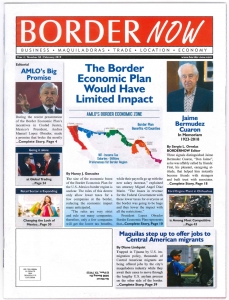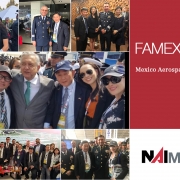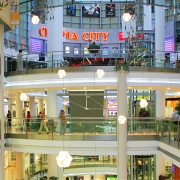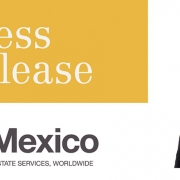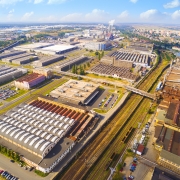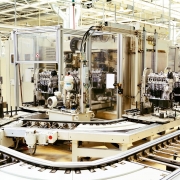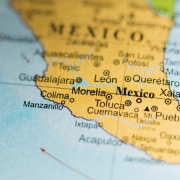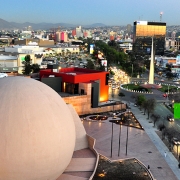Over the past five years, retail investors and developers have added a new imprint to the familiar terrain of cheek-by-jowl, mom-and-pop stores across Mexico, building U.S.-style strip and destination malls with brand name tenants.
The trend is growing across Mexico. And, at the U.S.-Mexico border, the creation of a special border economic zone that will halve the VAT sales tax, as well as cut corporate taxes, and double the minimum wage is expected by some to spur even faster expansion.
“This city is seeing right now an explosion in mixed-use projects”
said Harold Hoekstra, the Tijuana-based director of mixed-use development at consulting firm NAI Mexico.
“You’ll see it across the country, too, say in Guadalajara, Monterrey, Juarez. Companies are seeing the potential to invest in these sectors,” he said.
The increase of retail projects, often combined with offices, hotels, and residences, is exactly the opposite of what is happening in the United States, where traditional customers have largely shunned malls for online shopping. According to various articles, the number of store closings in the United States was expected to be more than 10,000 in 2018. Malls are either closing completely or have become collections of empty stores.
Horton Plaza, a San Diego project that opened in 1985 and was credited with revitalizing the city’s downtown, has become something of an eyesore. It recently was sold to Los Angeles commercial real estate company Stockade Capital, which plans to turn the shopping center into a mix of retail and office space that could appeal to Silicon Valley technology companies.
In Mexico, there has been 5% annual growth in the gross leasable area of commercial centers and an increase of 7.5% in retail sales.
“We’re still 10 to 20 years away from online operations decimating mall store operations” Hoekstra said.
“Mexicans like to go shopping. The malls are very strong. The numbers are good.”
Most of the mall developers are Mexican or South American, he said.
Plaza Sendero has built and operates 19 malls across Mexico—in addition to Tijuana and Mexicali, in Culiacan, Los Mochis and Ciudad Obregon, among other cities.
Mexican company Planigrupo, with 43 years of experience, develops, designs, builds, markets, and administers shopping centers throughout Mexico.
In Tijuana, some of the projects are in a revitalizing city center or in far-reaching areas of the city where spreading populations have become concentrated.
The Alameda Otay Town Center, located near the airport and the Otay Mesa border crossing has 163 shops, six residential towers, two hotels, and a medical center with 90 offices. Green areas are pet friendly. The mall also offers cultural events, Wi-Fi, parking and valet parking, as well as an outdoor auditorium.
Closer to downtown, the two-story Paseo Chapultepec, in addition to shops, restaurants and beer pubs, includes walkways, terraces and galleries.
Tenants at the malls include well-known brand names such as Best Buy, Costco, Applebee’s and Home Depot. Apple has stores in malls in Tijuana, Mexico City, Guadalajara and Monterrey.
South American brands also are becoming important mall tenants. Sodimac, a Chilean home improvement warehouse chain, is popping up. And Argentinian, Colombian and Peruvian stores are gaining a presence in Mexico, Hoekstra said.
Even though Mexican upscale department stores such as Liverpool and Palacio del Hierro are expanding to malls in the interior, he said, they are reluctant to establish operations in the border region because of the competition of their higher-end merchandise with U.S. retailers.
Many expect President Andres Manuel Lopez Obrador’s creation of incentives for the border economic zone to spur even further development.
“It’s a nice windfall for retailers; it will provide an incentive to the area”
said Jose “Pepe” Larroque, a Baker & McKenzie partner who chairs the law firm’s global real estate practice group.
Still, he said, the special program is scheduled to last for only two years and then be reevaluated, “so it’s hard to do long-term planning.”
Many details of the new zone are still unknown, but companies must register to gain the economic perks, companies or their branches must already be established in the zone and new companies are supposed to have new equipment in the zone for the first time.
“It might generate more investment in the border zone, but it’s still unclear,” Larroque said.
For U.S. landlords, investors and operators of retail centers, shopping malls, lifestyle centers and similar projects investing in Mexico it’s different than in the United States, said NAI’s Hoekstra.
One criterion is the same on both sides of the border, however: “location, location, location.”
But the capitalization rate (or cap rate), the most popular measure through which real estate investments are assessed for their profitability and return potential, is not the same.
“The retail sector in the United States averages a 7% cap rate,” Hoekstra said. “On the Mexican side, you have to look at 9% or higher … The interesting thing is that those deals are there.”
When acquiring a retail property in Mexico, he said, investors should want to know who the tenants are—especially the anchor tenants, what the lease terms are and their reliability to remain as tenants and keep paying rent.
With many Mexican shopping centers including brands seen in the United States and Canada, investors could start with clients they have north of the border. “Walmart has been a driver,” Hoekstra said.
Lastly, he said, is there a market?
For a landlord, there are retail centers for sale in appropriate locations with the right set of criteria and there is land for sale to develop malls or mixed-used projects, he said.
For retailers wanting to make the decision to increase their presence or undertake a project in Mexico, he added, the Mexican middle class is growing and has increased purchasing power and infrastructure has improved.
At the border, noted Larroque, the special economic zone could move more wealth to the region. With the doubling of the minimum wage, he said,
“More people will be making more money and will have cash to spend—on housing, retail, trade and commerce.”
Plus, it is more difficult to cross the border to shop in the United States, he noted.
“What newcomers are going to be investing?” he asked. “That’s where the questions lie.”
This article was originally written by Diane Linquist and published in the February 2019 edition of the Border Now
